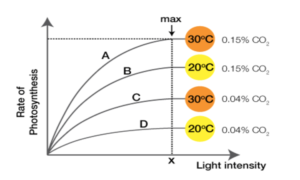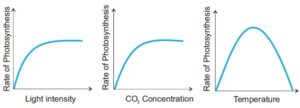Factors affecting Photosynthesis
Factors Affecting Photosynthesis: The slowest factor implies a factor which is present in intensity or quantity that is less than what is required for the process, when two to more factors act at the same time. To explain the meaning of his principle Blackman cited the following example.
Suppose a leaf is subjected to a light intensity sufficient to decompose 5 c.c. of CO2 per hour and only 1 c.c. of the gas is available, photosynthesis will continue at a certain rate since light intensity is not a limiting factor.
Internal (Plant) & External
Internal – Internal affected by plant genetic makeup and growth. E.g., Number, size, age, the orientation of leaves, mesophyll cells, chloroplast, internal CO2 concentration, amount of chlorophyll.
External – E.g., availability of sunlight, Temperature, CO2 concentration, H2O, light intensity, incident light.
Initially, Scientists assumed high CO2 absorption in leaves high rate of assimilation, tall plant growth. This changed when Fredrick Blackman performed the experiment.
Click Here for all Biology Notes
Blackman- Law of limiting Factors – (1905)
If the chemical process is affected by more than 1 factor, its rate will be determined by a factor nearest to its minimal value. It is a factor that directly affects the process of its quantity is changed. E.g., Despite the process of its amount is changed. E.g., despite the presence of green leaf, optimal light, CO2 plants may not photosynthesis if the temperature is shallow.
1 . Light –
- At low light intensity, incident light has a linear relationship with photosynthesis.
- Incident light increases photosynthesis increases.
- At high intensity, photosynthesis does not show further increase as other factors become limiting.
- Light saturation occurs at 10 x of full sunlight. So, except for plants in shade or dense forests, light is rarely a limiting factor.
- More incident light beyond light saturation causes a breakdown of chlorophyll. & Less photosynthesis.
- Intensity: Photosynthesis begins at low intensities of light and increases till it is maximum at the brightest time of the day. The amount of light required varies for different plants. Photosynthesis uses maximum up to 1.5 % light in the process and so light is generally not a limiting factor at high intensity. However, the light becomes a limiting factor in low intensity because no matter how much water or CO2 is present, without light photosynthesis cannot occur. At high intensities, the temperature of the plant increases which leads to increased transpiration in the plant. This leads to the closing of the stomata which leads to a reduced CO2 intake. Thus, leading to a reduction and finally stoppage of photosynthesis. Therefore, excessive light inhibits photosynthesis.
- Quality: Experiments conducted by Engelmann prove that the chlorophyll most effectively absorbs red and blue wavelengths from the entire spectrum of light. Thus, maximum photosynthesis occurs when the plant is exposed to the light of these wavelengths.
- Duration: The longer the plant is exposed to light, the longer the process of photosynthesis will continue. As long as the temperature of the plant remains balanced, photosynthesis will occur.
2. CO2 –
- Atmospheric concentration between 0.03 & 0.04 % – major limiting factor.
- In less light conditions, more CO2 does not affect the rate of photosynthesis.
- At more light, both C3 & C4 show high in photosynthesis with increased CO2.
- C4 attain saturation at 360 µl/L while C3 beyond 450 µl/L.
- So, CO2 concentration is a limiting factor for C3 plants as they respond to high CO2.
- This is used by farmers who grow crops such as tomato & bell pepper in a greenhouse where more CO2 concentration high crop yield.
3. Temperature –
- The dark reaction being enzymatic, have more effect on temperature than light reaction.
- C4 plants have an optimum temperature of 350 C high rate of photosynthesis high temperature.
- C3 plants – O.T. – 250C; C4 show high photosynthesis than C3 at high temperature.
- Tropical plant’s photosynthesis remains unaffected by more temperature, but in temperate plants, photosynthesis is low with high temperature as they have low optimum temperature than tropical plants.
4. Water –
- Indirect factors affect plants rather than photosynthesis.
- Water stress causes stomata to close – low CO2, low surface area as forces, leaves to wilt (curl), low photosynthetic.
Factors Affecting Photosynthesis Citations
Factors affecting photosynthesis
Genetic variation in transcription factors and photosynthesis light-reaction
The influence of stomatal morphology and distribution on photosynthetic gas exchange
Related Posts
- Phylum Porifera: Classification, Characteristics, Examples
- Dissecting Microscope (Stereo Microscope) Definition, Principle, Uses, Parts
- Epithelial Tissue Vs Connective Tissue: Definition, 16+ Differences, Examples
- 29+ Differences Between Arteries and Veins
- 31+ Differences Between DNA and RNA (DNA vs RNA)
- Eukaryotic Cells: Definition, Parts, Structure, Examples
- Centrifugal Force: Definition, Principle, Formula, Examples
- Asexual Vs Sexual Reproduction: Overview, 18+ Differences, Examples
- Glandular Epithelium: Location, Structure, Functions, Examples
- 25+ Differences between Invertebrates and Vertebrates
- Lineweaver–Burk Plot
- Cilia and Flagella: Definition, Structure, Functions and Diagram
- P-value: Definition, Formula, Table and Calculation
- Nucleosome Model of Chromosome
- Northern Blot: Overview, Principle, Procedure and Results

















